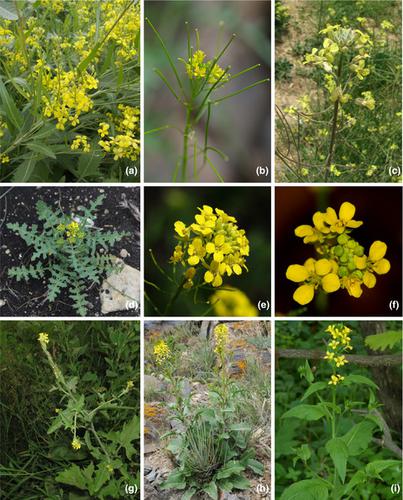当前位置:
X-MOL 学术
›
Ecol. Evol.
›
论文详情
Our official English website, www.x-mol.net, welcomes your
feedback! (Note: you will need to create a separate account there.)
A story from the Miocene: Clock‐dated phylogeny of Sisymbrium L. (Sisymbrieae, Brassicaceae)
Ecology and Evolution ( IF 2.3 ) Pub Date : 2021-03-02 , DOI: 10.1002/ece3.7217 Anže Žerdoner Čalasan 1 , Dmitry A German 2 , Herbert Hurka 1 , Barbara Neuffer 1
Ecology and Evolution ( IF 2.3 ) Pub Date : 2021-03-02 , DOI: 10.1002/ece3.7217 Anže Žerdoner Čalasan 1 , Dmitry A German 2 , Herbert Hurka 1 , Barbara Neuffer 1
Affiliation

|
Morphological variability and imprecise generic boundaries have hindered systematic, taxonomical, and nomenclatural studies of Sisymbrium L. (Brassicaceae, Sisymbrieae DC.). The members of this almost exclusively Old‐World genus grow mostly on highly porous substrates across open steppe, semidesert, or ruderal habitats in the temperate zone of the Northern Hemisphere and African subtropics. The present study placed the biological history of Sisymbrium L. into time and space and rendered the tribus Sisymbrieae as monotypic. Five nuclear‐encoded and three chloroplast‐encoded loci of approximately 85% of all currently accepted species were investigated. Several accessions per species covering their whole distribution range allowed for a more representative assessment of intraspecific genetic diversity. In the light of fossil absence, the impact of different secondary calibration methods and taxon sets on time spans was tested, and we showed that such a combinatorial nested dating approach is beneficial. Multigene phylogeny accompanied with a time divergence estimation analysis placed the onset and development of this tribus into the western Irano‐Turanian floristic region during the Miocene. Continuous increase in continentality and decrease in temperatures promoted the diversity of the Sisymbrieae, which invaded the open grasslands habitats in Eurasia, Mediterranean, and South Africa throughout the Pliocene and Pleistocene. Our results support the assumption of the Irano‐Turanian region as a biodiversity reservoir for adjacent regions.
中文翻译:

中新世的故事:Sisymbrium L.(Sisymbrieae,十字花科)的时钟年代系统发育
形态变异性和不精确的属界界限阻碍了Sisymbrium L.(十字花科、Sisymbrieae DC.)的系统、分类和命名研究。这个几乎完全是旧世界属的成员主要生长在北半球温带和非洲亚热带的开放草原、半沙漠或原始生境的高度多孔基质上。本研究将Sisymbrium L. 的生物学历史置于时间和空间中,并将 Sisymbrieae 视为单一型。对目前所有公认物种中大约 85% 的 5 个核编码位点和 3 个叶绿体编码位点进行了研究。每个物种有几个覆盖其整个分布范围的材料,可以对种内遗传多样性进行更具代表性的评估。鉴于化石缺失,测试了不同的二次校准方法和分类单元集对时间跨度的影响,我们表明这种组合嵌套测年方法是有益的。多基因系统发育与时间分歧估计分析将该分支的起源和发展置于中新世期间的伊朗-图兰西部植物区系区域。大陆性的持续增加和气温的下降促进了Sisymbrieae的多样性,它们在上新世和更新世期间入侵了欧亚大陆、地中海和南非的开阔草原栖息地。我们的结果支持伊朗-图兰尼亚地区作为邻近地区生物多样性库的假设。
更新日期:2021-03-21
中文翻译:

中新世的故事:Sisymbrium L.(Sisymbrieae,十字花科)的时钟年代系统发育
形态变异性和不精确的属界界限阻碍了Sisymbrium L.(十字花科、Sisymbrieae DC.)的系统、分类和命名研究。这个几乎完全是旧世界属的成员主要生长在北半球温带和非洲亚热带的开放草原、半沙漠或原始生境的高度多孔基质上。本研究将Sisymbrium L. 的生物学历史置于时间和空间中,并将 Sisymbrieae 视为单一型。对目前所有公认物种中大约 85% 的 5 个核编码位点和 3 个叶绿体编码位点进行了研究。每个物种有几个覆盖其整个分布范围的材料,可以对种内遗传多样性进行更具代表性的评估。鉴于化石缺失,测试了不同的二次校准方法和分类单元集对时间跨度的影响,我们表明这种组合嵌套测年方法是有益的。多基因系统发育与时间分歧估计分析将该分支的起源和发展置于中新世期间的伊朗-图兰西部植物区系区域。大陆性的持续增加和气温的下降促进了Sisymbrieae的多样性,它们在上新世和更新世期间入侵了欧亚大陆、地中海和南非的开阔草原栖息地。我们的结果支持伊朗-图兰尼亚地区作为邻近地区生物多样性库的假设。











































 京公网安备 11010802027423号
京公网安备 11010802027423号